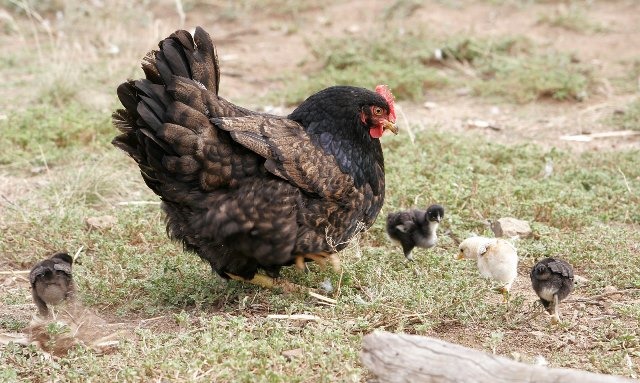The Caring Chicken – Being a Mother Hen

Guest post by Christina M. Colvin
On September 4th, 1,150 chickens from a factory farm in California, took to the air on a chartered plane and landed the following morning in New York. It was all part of a plan, spearheaded by the Animal Place sanctuary and aided by Farm Sanctuary and other groups, to retire a total of 3,000 egg-laying hens to good new homes.
Egg-laying hens are usually consigned to the gas chamber as soon as they become exhausted from laying eggs, which is usually before they are three years old. But in this case the hens got a reprieve.
Despite the continuously emerging evidence that suggests mother hens care about their downy chicks, the factory farming system prevents them from engaging in the very hallmark behaviors for which mother hens are so renowned. Human mothers and chicken mothers have something very important in common – the welfare of their children. But at factory farms, the hens have no opportunity at all to raise their young.
There are lots of very good reasons why mother hens are known as caring parents.
Throughout popular culture, children’s literature, and spiritual texts, one animal pervades as a symbol of maternal care and attentiveness: the mother hen. Despite her recognizability as an emblem of motherly devotion, however, most egg-laying hens in the United States spend their entire lives in the tiny, cramped, filthy quarters of factory farm battery cages, a place impossible for her to live up to her reputation.
Recent scientific studies of mother hens—particularly their responsiveness to the condition of their feathered children—warrant special attention for a consideration of modern agriculture’s treatment of these perceptive and sensitive animals. Indeed, such studies suggest that the care shown by chicken moms for their children is far from the stuff of stories alone, and that the mother hen earned her prestige as a caring parent for good reasons.
Don’t Talk to Strangers
When given the chance, the mother hen is constantly on the lookout for threats to her chicks. All chickens use different calls to designate aerial predators like hawks and owls from ground hunters like foxes and coyotes, showing that they can both assess a threat and tell other chickens how to prepare themselves.
Mother hens in particular evaluate predators according to another criterion—size—in order to determine if a hungry carnivore poses a threat to her chicks specifically. By judging a predator’s size relative to the size of her children, mother hens only sound an alarm when the predator looks big enough to take her chicks away.
Eat Your Spinach
Mother hens even get involved with what their kids eat. One recent study showed mother hens discouraging their children from consuming food they understood to be unsuitable. Conditioned to identify one color of food as preferable and another color of food as unsuitable, this study had mother hens watch from a separate room as their chicks chose to eat the color of feed they (the hens) deemed less preferable.
Perceiving the chicks making an error determining which food was palatable and which was not, the mother hens responded by pecking and scratching the ground more frequently in attempt to attract their chicks away from the bad food and toward the better food.
Come to Mommy!
Mother hens also seem to really empathize with their chicks. One group of researchers exposed hens and chicks to a mildly upsetting (but not harmful) stress: a puff of air. Watching from a connected room but unable to get to their chicks, mother hens responded more intensely when they saw their chicks receive an air puff than when they (the mothers) received one: seeing their chicks in distress, the hens’ hearts beat more quickly, their body temperatures changed, and they attempted to call their chicks to their sides, away from the perceived threat.
Although none of the 3,000 hens rescued by Animal Place had ever been outside, seen the sun or stepped on the grass, the first group of them were soon doing all the kinds of things that are natural to hens – like enjoying their first dust baths. We’re delighted that they’re finding their way to good new homes where they can live out their days as nature intended.
Christina Colvin, who will graduate with a Ph.D. in English from Emory University in May 2014, specializes in 20th and 21st-Century American literature and animal studies, with a particular interest in texts depicting ecological crises and odd encounters between humans and animals. Her most recent writing and professional presentations have focused on William Faulkner’s critique of speciesism, the permutations of taxidermy as a cultural signifier, and the vexed relationship between animal welfare and the rhetoric of sustainability. Christina aims for her academic and public scholarship to spark renewed interest in animals in both literary studies and the world.
2 Replies to “The Caring Chicken – Being a Mother Hen”
Comments are closed.

[…] the Kimmela Center for Animal Advocacy, directed by Dr. Lori Marino, published my blog entry, “The Caring Chicken – Being a Mother Hen.” In this post I review several recent scientific studies of mother hens to show that these […]
Rescuing 3,000 chicken and hiring a private jet just for that was inspiring. Mother hens are one of the greatest protectors of their offspring. Fearless when with their chicks but back to shyness after they are grown and safe. It is great to know that there are people out there who care so much about domestic animals.